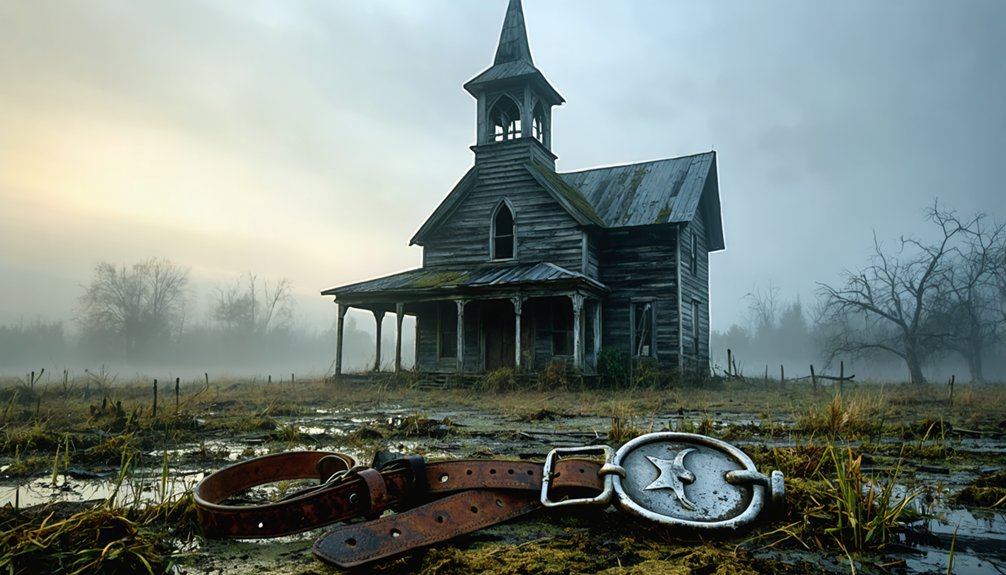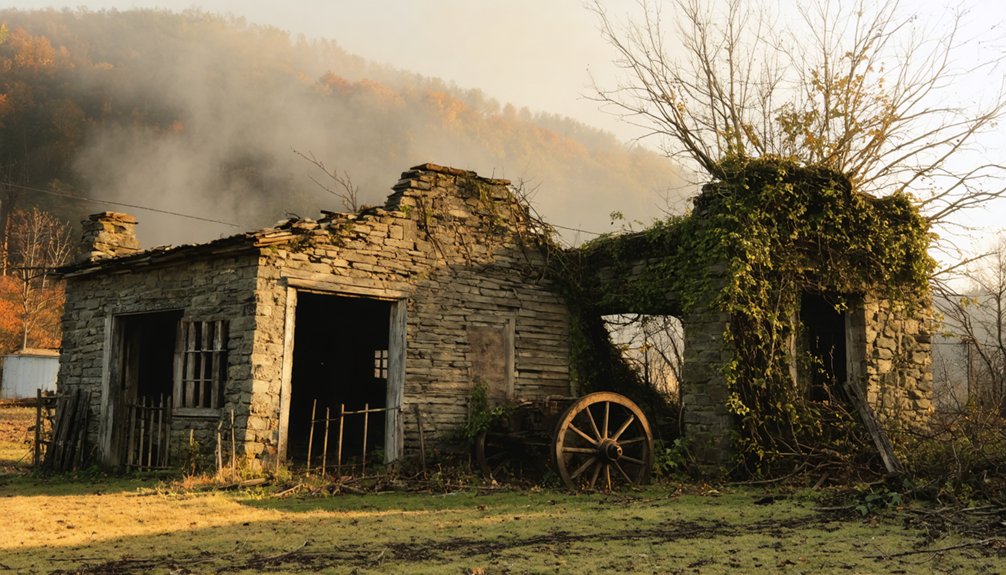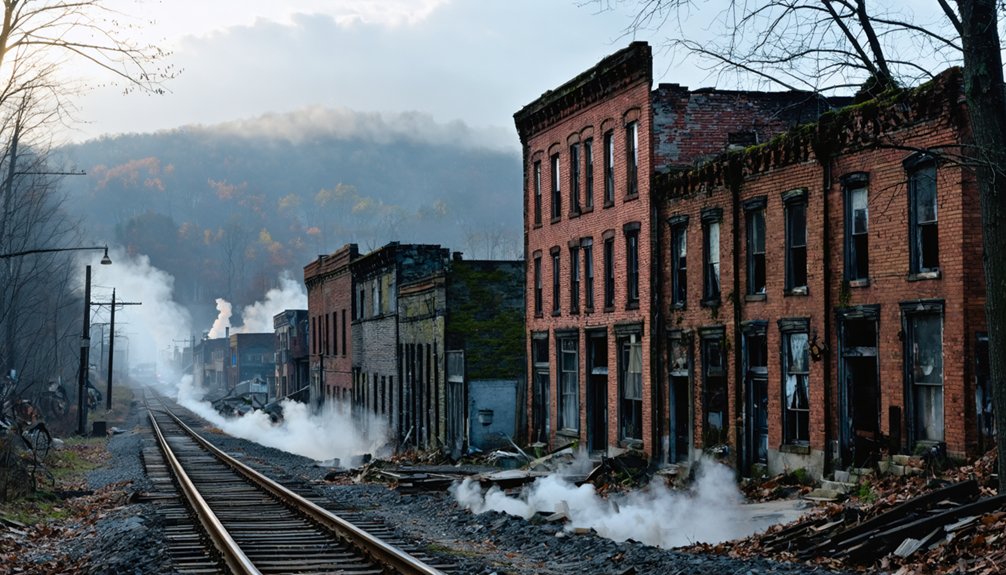America’s Civil War left behind enchanting ghost towns awaiting your discovery. You’ll encounter Alabama’s abandoned capital Cahawba, Harpers Ferry’s raid site, Andersonville’s notorious prison camp, Ellicott City’s battle-scarred streets, Port Royal’s forgotten naval base, Shiloh’s battlefield remnants, and New Philadelphia’s free Black settlement. These haunting locations preserve both structural remains and reported paranormal phenomena, offering tangible connections to the nation’s most divisive conflict. The stories these silent witnesses hold will transform your understanding of history.
Key Takeaways
- Cahawba, Alabama’s first state capital, succumbed to flooding and now hosts Richard Upjohn’s Gothic Revival church ruins and Civil War prison remains.
- Harpers Ferry features abandoned structures where visitors report spectral marching sounds from its tumultuous Civil War history.
- Andersonville’s remains showcase the infamous prison camp where 13,000 Union soldiers died from starvation and disease.
- New Philadelphia preserves the layout of a free Black settlement that served as an Underground Railroad station before economic decline.
- Port Royal contains abandoned fortifications from a pivotal Union naval victory that established recruitment centers for formerly enslaved people.
Cahawba: Alabama’s Abandoned Capital With Union Prison History
Situated at the strategic confluence of the Alabama and Cahaba rivers, Cahawba emerged as Alabama’s first permanent state capital in 1819, embodying the ambitious vision of a nascent state seeking to establish its political identity.
Built upon ancient Mississippian settlements, the town flourished briefly before chronic flooding prompted the capital’s relocation to Tuscaloosa in 1826.
The ambitious capital’s early promise succumbed to nature’s persistent challenge, forcing Alabama’s political center to higher ground.
Despite this setback, Cahawba’s architecture evolved impressively during its antebellum heyday, featuring Richard Upjohn’s Gothic Revival church and elegant residences that reflected its prosperity as a cotton distribution hub. The town’s frequent flooding brought swarms of mosquitoes that spread yellow fever epidemics among residents. The town was designed with a grid layout similar to Philadelphia, with streets named after trees.
During the Civil War, the town’s Confederate legacy was cemented when a warehouse became Castle Morgan, an overcrowded prison where thousands of Union soldiers endured dire conditions.
Following the war, Cahawba transformed into a freedmen’s community before floods and economic decline rendered it a hauntingly empty monument to Southern history.
Harpers Ferry: Where History and Haunting Meet at John Brown’s Raid Site
Straddling the strategic confluence of the Potomac and Shenandoah Rivers, Harpers Ferry embodies the turbulent intersection of America’s most pivotal historical tensions and their spectral aftermath.
John Brown’s 1859 raid on the federal armory—seizing watchmen, cutting telegraph wires, and attempting to arm enslaved people—catalyzed the nation toward Civil War. This defining moment in Harpers Ferry history resonates through paranormal encounters reported along High Street, where witnesses describe spectral marching and a child’s ghostly cries.
You’ll discover a town that changed hands fourteen times during the war, with both armies recognizing its critical railroad junction and armory. The vulnerable town’s low elevation made it difficult to defend without controlling the surrounding heights, leading to repeated conquests and abandonments.
The first casualty of Brown’s raid was Heyward Shepherd, a free Black man mistakenly shot by the raiders, adding another layer of tragic irony to the event.
Confederate forces eventually destroyed the arsenal, with salvaged machinery shipped south to Richmond. John Brown’s legacy persists not only in historical narratives but also in unexplained phenomena that echo the violence of a nation divided.
Andersonville: Remnants of the South’s Most Notorious Prison Camp
Among the darkest chapters of Civil War history, Andersonville Prison stands as a haunting symbol of the conflict’s brutal human cost.
When you visit this former Confederate camp, you’ll walk the grounds where over 45,000 Union soldiers were imprisoned in a space designed for just 10,000. The overwhelming prison conditions created a death trap where nearly 13,000 men perished. The dreaded stockade of logs surrounded the entire prison, standing 15 to 17 feet high to prevent escape.
As you explore the site, imagine the desperate struggle against starvation, disease, and exposure that defined daily life here. Camp mortality reached staggering levels—approximately 100 deaths daily during peak periods.
Though Confederate guards could forage outside for food, prisoners subsisted on meager rations while battling dysentery, scurvy, and violence from fellow inmates in a desperate fight for survival. The prison’s contaminated water supply significantly worsened the already dire living conditions for inmates.
Ellicott City: Maryland’s Mill Town Scarred by Confederate Raids
While the devastating consequences of the Civil War unfolded across major battlefields, Ellicott City emerged as a strategic flashpoint where industrial capability and military necessity collided violently. Founded as a mill town in 1771, this Maryland settlement became essential to Union logistics by 1861.
The industrial gears of Ellicott City transformed into vital Union lifelines amid a Maryland community split by national conflict.
You’ll find a community deeply divided yet dominated by Union sentiment, with mill workers staunchly supporting Northern causes while scattered Southern sympathizers remained. The B&O Railroad Station—America’s oldest surviving rail terminus—became a prime target for Confederate raids designed to disrupt critical supply lines. The nearby Ellicott City Colored School was built by African American veterans after the war concluded.
Union troops established camps throughout the area to protect the Thomas Viaduct and other strategic infrastructure. Confederate prisoners were marched through town, leaving behind spectral energy that contributes to the area’s haunted reputation.
Today, ghostly remnants of this tumultuous era persist in local lore, including spectral footsteps of a fleeing Confederate soldier echoing down stone staircases—physical manifestations of a community torn by war.
A decisive Union naval victory in November 1861 transformed Port Royal Sound into what would become the most significant Union naval installation in the Confederacy. Flag Officer Samuel Du Pont‘s innovative elliptical attack strategy overwhelmed Confederate earthworks with minimal Union casualties, securing this strategic harbor.
Port Royal’s Union occupation created a powerful operational hub where you can still trace remnants of:
- The South Atlantic Blockading Squadron’s headquarters that strangled Confederate supply lines
- Repair facilities where damaged warships were restored to fighting condition
- Recruitment centers where thousands of formerly enslaved people joined Union forces
- The groundbreaking “Port Royal Experiment” that established African American self-sufficiency
This forgotten base represented more than military advantage—it embodied the Union’s naval strategies while simultaneously becoming a liberation point where freedom took root amid war’s destruction. New yards were established at Port Royal Sound specifically to support blockading operations and provide a strategic base in Confederate territory. Located on the Rappahannock River, Port Royal provided crucial military movement access as the last point where Union forces could bridge the river with pontoons.
Shiloh: Battlefield Ghosts Among Tennessee’s Abandoned Settlements
As you walk Shiloh’s hallowed grounds, you’ll encounter numerous reports of phantom soldiers appearing near the “Hornet’s Nest” and along the battlefield’s most contested areas.
The crumbling remains of historic structures, including deteriorating cabins and foundations from the original settlement, stand as silent witnesses to both the battle and subsequent abandonment.
Your experience might include the distinct yet vanishing sounds of artillery fire and battle cries that hundreds of visitors have documented hearing, especially near “Bloody Pond” where paranormal phenomena persist despite the peaceful Tennessee landscape that has reclaimed the once-violent terrain.
Phantom Soldier Sightings
The blood-soaked fields of Shiloh National Military Park harbor more than just historical memories; they’ve become a nexus for some of America’s most compelling phantom soldier encounters.
As you walk these hallowed grounds, you’ll encounter a haunting history that refuses to fade into obscurity.
- Shadowy Confederate and Union spectral soldiers silently reenact their final moments across battlefields, particularly near the rebuilt Shiloh Church.
- Sensory phenomena assault visitors—disembodied footsteps, phantom cannon fire, and the inexplicable scent of gunpowder hanging in still air.
- The infamous “Old Green Eyes,” a skeletal figure in Confederate gray, appears on horseback calling for “Amy” before vanishing.
- Overwhelming melancholy permeates certain areas, especially the Hornet’s Nest and Bloody Pond, where 23,000 casualties occurred.
Vanishing Artillery Sounds
Visitors walking the serene landscapes of Shiloh National Military Park often find their contemplative silence shattered by phantom artillery explosions that materialize without warning, then vanish just as mysteriously into the Tennessee air.
These battlefield memories persist where over 23,000 casualties fell in April 1862, many buried in mass graves that punctuate the landscape. The phantom echoes—distant cannon fire, musket volleys, drumbeats, and soldiers’ cries—are most prevalent near sites of heaviest combat.
What makes these phenomena particularly compelling is their layered historical context: Civil War violence overlays abandoned prehistoric Indian settlements and ancient burial mounds.
The unresolved trauma seems embedded in the land itself, creating auditory imprints that continue to resonate across time. When you visit, the eerie juxtaposition between the park’s current tranquility and these lingering sounds offers a visceral connection to America’s bloodiest conflict.
Crumbling Historic Structures
Beyond the ghostly sounds that haunt Shiloh’s air lies a landscape where history physically crumbles before your eyes. This rare preservation site contains the visible remains of both Civil War and prehistoric Native settlements, largely undisturbed by modern development.
As you traverse the battlefield, you’ll encounter:
- Collapsed wooden structures with low remnants marking Civil War positions
- Prehistoric earthen mounds with visible rings from an 800-year-old fortified town
- Mass Confederate graves marking hallowed ground where 23,000 casualties fell
- Deteriorating daub wall fragments—among the only visible prehistoric domestic structures in the eastern U.S.
The historic preservation efforts at Shiloh intentionally maintain these crumbling structures in their natural state of decay, creating an authentic connection to the past.
The battlefield’s haunting integrity persists precisely because development has been kept at bay, allowing you to experience history’s physical remnants.
New Philadelphia: The Free Black Town That Witnessed War’s Devastation
While most Civil War ghost towns emerged from direct battle damage, New Philadelphia represents a more nuanced casualty of the era’s social and economic transformations. Founded in 1836 by Frank McWorter, who purchased his own freedom before establishing this remarkable community, the town embodied Black Freedom aspirations amid hostile racial codes.
You’ll find little remaining of what once served as an Underground Railroad station and multiracial market town. The community’s decline began after McWorter’s death in 1854, accelerated when the railroad deliberately bypassed the settlement. By 1885, economic viability had collapsed entirely.
Today, archaeological excavations have uncovered the town’s layout and artifacts, preserving the Community Legacy of America’s first legally registered Black-founded town.
The New Philadelphia National Historic Site now commemorates this pioneering experiment in interracial cooperation during America’s most divided era.
Frequently Asked Questions
Can Children Safely Visit These Civil War Ghost Towns?
Yes, children can safely visit with proper supervision. You’ll find family safety improves through following guidelines, while educational opportunities abound in these historical settings that foster understanding of America’s pivotal conflict.
What Paranormal Equipment Should I Bring for Ghost Hunting?
You’ll need essential equipment including EMF detectors, spirit boxes, audio recorders, thermal cameras, and REM pods. Don’t forget protective gear, extra batteries, and documentation tools for analyzing paranormal phenomena effectively.
Are There Accessible Facilities for Visitors With Mobility Challenges?
Most Civil War ghost towns offer wheelchair accessibility at visitor centers, though battlefield terrains vary. You’ll find designated parking options, paved paths, and trained staff to accommodate your mobility challenges.
When Is the Best Season to Witness Paranormal Activity?
Fall brings heightened encounters, summer nights deliver unexpected phenomena. You’ll find peak paranormal activity during October-November when autumn’s atmospheric conditions, fall foliage, and commemorative battle anniversaries converge to intensify spectral manifestations.
How Do Local Indigenous Peoples View Tourism at These Sites?
Indigenous perspectives on tourism are complex—you’ll find many communities concerned about cultural commodification and land rights, while others leverage tourism for economic opportunities and cultural revitalization. Cultural sensitivity remains essential.
References
- https://devblog.batchgeo.com/ghost-towns/
- https://en.wikipedia.org/wiki/Wikipedia:WikiProject_Ghost_towns
- https://www.loveexploring.com/gallerylist/131658/abandoned-in-the-usa-92-places-left-to-rot
- https://m.dresshead.com/files/scholarship/Documents/Ghost_Towns_Lost_Cities_Of_The_Old_West_Shire_Usa.pdf
- https://www.christywanders.com/2024/08/top-ghost-towns-for-history-buffs.html
- https://www.tastingtable.com/694562/scariest-ghost-towns-country/
- https://www.blueridgeoutdoors.com/go-outside/southern-ghost-towns/
- https://en.wikipedia.org/wiki/Wikipedia:WikiProject_Ghost_towns/Assessment
- https://www.mentalfloss.com/geography/american-ghost-towns-can-still-walk-through
- https://en.wikipedia.org/wiki/Ghost_town



